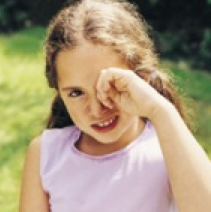Allergies or Asthma?
 Allergies and asthma are by no means rare among children across the United States. Allergies and asthma often start in childhood and continue throughout life. Although neither can be cured, with proper care they can usually be kept under control. Allergies are caused by the body’s reaction to substances called “allergens,” which trigger the immune system to react to harmless substances as though they were attacking the body.
Allergies and asthma are by no means rare among children across the United States. Allergies and asthma often start in childhood and continue throughout life. Although neither can be cured, with proper care they can usually be kept under control. Allergies are caused by the body’s reaction to substances called “allergens,” which trigger the immune system to react to harmless substances as though they were attacking the body.
When to Suspect an Allergy
Some allergies are easy to identify by the pattern of symptoms that follows exposure to a particular substance. But others are subtler, and may masquerade as other conditions. Here are some common clues that could lead you to suspect your child may have an allergy.
Repeated or chronic cold-like symptoms that last more than a week or two, or that develop at about the same time every year. These could include:
- Runny nose
- Nasal stuffiness
- Sneezing
- Throat clearing
- Nose rubbing
- Sniffling
- Snorting
- Sneezing
- Itchy, runny eyes
Itching or tingling sensations in the mouth and throat. Itchiness is not usually a complaint with a cold, but it is the hallmark of an allergy problem. Coughing, wheezing, difficulty breathing, and other respiratory symptoms. Recurrent red, itchy, dry, sometime scaly rashes in the creases of the skin, wrists, and ankles also may indicate an allergy.
Eczema
When it comes to rashes, the most common chronic inflammatory skin condition in children is eczema, also called atopic dermatitis. Although not strictly an allergic disorder, eczema in young children has many of the hallmarks of allergies and is often a sign that hay fever and asthma may develop. The rate of eczema, like that of asthma, is increasing throughout the world. Where asthma is rare, the rate of eczema is also low.
When to Suspect Asthma
Although allergies and asthma often go together, they are actually two different conditions.
- Asthma is a chronic condition that starts in the lungs.
- Allergies are reactions that start in the immune system.
Not everybody with allergies has asthma, but most people with asthma have allergies.
Asthma Attacks
The airways of the typical child with asthma are infl amed or swollen, which makes them oversensitive. When they come in contact with an asthma “trigger”— something that causes an asthma attack — the airways, called bronchial tubes, overreact by constricting (getting narrower).
Many different substances and events can “trigger” an asthma attack:
- Exercise
- Cold air
- Viruses
- Air pollution
- Certain fumes
- Other allergens
In fact, about 80 percent of children with asthma also have allergies and, for them, allergens are often the most common asthma triggers.
Common Allergens in Home and School
In the fall, many indoor allergens cause problems for children because they are inside of home and school for longer periods.
- Dust: contains dust mites and finely ground particles from other allergens, such as pollen, mold, and animal dander
- Fungi: including molds too small to be seen with the naked eye
- Furry animals: cats, dogs, guinea pigs, gerbils, rabbits, and other pets
- Clothing and toys: made, trimmed, or stuffed with animal hair
- Latex: household and school articles, such as rubber gloves, toys, balloons; elastic in socks, underwear, and other clothing; airborne particles
- Bacterial enzymes: used to manufacture enzyme bleaches and cleaning products
- Certain foods
Controlling Allergy Symptoms
- It’s helpful to use air conditioners, where possible, to reduce exposure to pollen in both your home and your car.
- Molds are present in the spring and late summer, particularly around areas of decaying vegetation. Children with mold allergies should avoid playing in piles of dead leaves in the fall.
- Dust mites congregate in places where food for them (e.g , flakes of human skin) is plentiful. That means they are most commonly found in upholstered furniture, bedding, and rugs.
- Padded furnishings, such as mattresses, box springs, pillows, and cushions should be encased in allergen-proof, zip-up covers, which are available through catalogs and specialized retailers.
- Wash linens weekly, and other bedding such as blankets, every 2 to 3 weeks in hot water to kill the dust mite.
- Pillows should be replaced every 2 to 3 years
Source: HealthyChildren.org